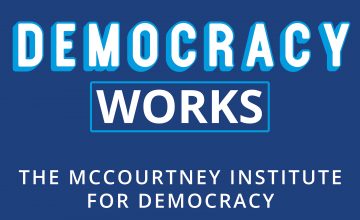Podcast: Play in new window | Download | Embed
Subscribe: Apple Podcasts | Spotify | Email | TuneIn | RSS | More

Last week, we heard from Salena Zito about the segments of middle America who supported Donald Trump after voting for Barack Obama. This week, we talk with another Pittsburgh resident, Lara Putnam, about a different version of Middle America — the college-educated, middle-aged suburban women who have dusted off the organizing skills honed through decades of volunteering to affect change in their communities.
Lara is a Professor and Chair of the History Department at the University of Pittsburgh and co-author with Theda Skockpol of the article “Middle America Reboots Democracy.” in the journal Democracy. She argues that grassroots work is happening behind the scenes in “purple” suburbs, areas that are ignored in the red state/blue state and urban/rural media narratives.
Grassroots groups like those Lara observed in western Pennsylvania are mixing traditional organizing tactics with social media to raise awareness and push for change at the local and state levels, far away from the divisions that bog down national politics. To borrow a line from the article, “If your question is how the panorama of political possibility has shifted since November 2016, your story needs to begin here.”
Thank you to WESA and WYEP in Pittsburgh for allowing us to use their community studio to record this interview with Lara.
Additional Information
Middle America Reboots Democracy in Democracy: A Journal of Ideas
Discussion/Reflection Questions
- What is the relationship between social engagement and political engagement?
- How does the populism Salena Zito described differ from the populism behind the groups Lara observed?
- Lara argues that local grassroots groups have been overlooked by the media and national political parties. Do you agree? If so, why do you think it’s happening?
- Both Republican and Democratic grassroots appear to want to make America great again. Can both visions of America coexist? Is there a possibility that these two less ideological groups merge into a new political coalition?
- Lara said that many of the grassroots groups she observed are lead by middle class women. Do you think the tone or activities of these groups would be different if they were run by younger women? Or by men?
Interview Highlights
[3:28] As a history professor, how did you come to write about a political movement?
Lara: After the 2016 election, I looked around at local politics to see where I could make a change. Based on the national political coverage, I expected to see high levels of energy and organization for progressive politics in the city and little in the suburbs. However, what I found was actually that I was missing the real story. What I saw in these smaller towns was people engaging again in the political process through organization. This wasn’t getting covered nationally. This is where I kicked into historical gear. We know that large scale changes nationally have their roots in local developments. Therefore, it leads us to believe that these changes at the local level should be looked at as the possible motivation behind future national changes. So face to face groups which appear insignificant, can actually lead to large political changes.
[6:35] What does middle America mean to you after your research?
Lara: These movements are being started by women. Particularly, women who had already been involved in the political movement prior to the 2016 election. What we mean by “middle America” here is that these democrat movements are taking place not in the stereotypical coastal democrat strongholds, but rather in small rural towns in the middle of the country.
[9:30] Why do you think the national media is missing this trend?
Lara: The national media is really obsessed with candidates. While this does impact the spread of movements like the ones we’re seeing, it doesn’t completely stop them. Remember that politics is local. Most political conversations and political knowledge is shared in local conversations such as when people are running errands in town. This is how information is usually shared. The media tends to underreport this type of grass roots kitchen table politics.
[11:30] Do these groups still see support from the Democratic Party?
Lara: Part of the story here is that the Democratic Party changed. This is why we’re seeing many of these groups being created recently. The party used to be structured in such as way that you could join it and know your fellow democrats. You had a sense that you belonged to an actual place with real people rather than simply an email list. How the party today has embraced these new organizations has varied around the country. In some places, the local party structure has embraced these new groups while in other places you’re seeing more resistance to bringing them into the fold. Whether or not this osmosis process happens depends a lot on the level of maturity of these groups. What I mean by that is how organized and structured they are. When a group is very structured, it tends to more naturally fold into a larger equally as organized group.
[17:25] Do you think there is room in these left leaning groups for someone who voted for Trump in 2016 but have since changed their minds?
Lara: I think there are many different “middle Americas” out there. People are complicated and terms such as progressive means different things in different places.
[21:31] How are these groups communicating and utilizing technology to advance their cause in 2018?
Lara: Some groups have become hybrids of older and newer models in that they’re utilizing both face to face as well as technological forms of communications. For example, groups will often have several facebook pages. One will be public where as the other will be private. This private page has sort of become the 21st century face to face conversation.
